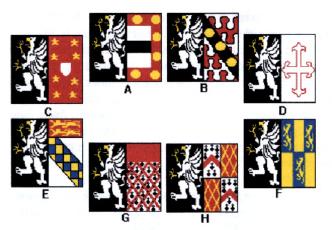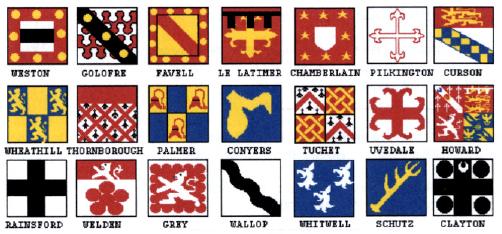David Broomfield
The chapel at Audley End was created between 1768 and 1772 for the owner General Sir John Griffin-Griffin, K.B. (1719-1797). It was formed out of the previous chapel, which in turn succeeded the Queen's Great Chamber in the original Jacobean house. The style chosen was the fashionable Strawberry Hill Gothick and stands in marked contrast to the original interiors of 1612 and the rooms commissioned by Sir John from Robert Adam.
The family pew was decorated with heraldry on the walls and the ceiling. Even the chairs have on their backs the simple, canting, arms of Griffin, Sable a griffin segreant argent. The heraldry performed three functions. The first was to show Sir John's descent from Sir Thomas Audley, K.G. (1488-1544), Lord Audley of Walden, Speaker, Lord Chancellor and recipient of the Abbey of Walden in 1538 at the dissolution of the monasteries. This descent was reinforced by the series of full-length paintings that Sir John commissioned to adorn the Saloon at Audley End. The second function was to show the genealogy of the Griffin family from the 12th century to Sir John. The third was decorative.

Figure 1. Quarterings from central cartouche on ceiling [Howard quartered with Brotherton, Mowbray and Audley]. 1: Griffin; 2: Favell; 3: Latimer; 4: Barybrook; 5: De La Warr; 6: Palmer; 7: Conyers; 8: D'Arcy; 9: Neville; 10: Neville (old); 11: Uvedale; 12: Howard (quarters); 13: Ransford
The walls and ceiling are divided into a series of cartouches formed by the ribs and spandrels of the gothic arches that adorn the walls. The entire structure is in fact made of lath and plaster and painted to imitate stone. The central cartouche in the ceiling is devoted to the quarterings of the Griffin family. A shield of thirteen quarters (Figure 1) is surrounded by eight shields for those ancestors that did not marry an heraldic heiress. These in turn are flanked by four further shields. Taken together they tell the story of the Griffin family in thirteen generations from the earliest recorded ancestor Sir Ralph Griffin (d. 1184) down to Sir John Griffin-Griffin (d. 1797). Every generation of the family married an armigerous lady, many of them heraldic heiresses.
Sir John (he was made a Knight of the Order of the Bath in 1761) had an abiding interest in the history and arms of his Griffin forebears. His paternal arms of Whitwell appear only once in the entire house. There is a set of 121 quarterings dedicated to Sir John compiled by Joseph Edmondson, Mowbray Herald Extraordinary. There is also a pedigree of the Griffins, complete with a knight on horseback and four medieval barons that is 12 feet long and 5 feet wide. It has been made for one of Sir John Griffin's forebears. This used to be in Audley End; it is now in the Essex County Record Office.
Sir John's interest was not just pride in a long, albeit maternal, lineage. The decoration in the chapel also drew attention to his descent from the Howards, Earls of Suffolk. In particular from Thomas Howard, the 1st Earl, builder of the Jacobean Palace of Audley End. Thomas had been summoned to Parliament in 1597 with the title Baron Howard de Walden (a deliberate echo of his grandfather's title of Baron Audley of Walden). This barony, unlike the earldom of 1603, could descend through the female line. Sir John spent a good deal of effort to make his right to this title. He owed his claim to the fact that the 3rd Earl of Suffolk had two daughters, the elder of whom, Lady Essex Howard, married Edward Griffin (d. 1710), 1st Lord Griffin of Braybrooke. Sir John's mother was grand-daughter of Edward and Essex. On the death of his aunt without issue in 1762, Sir John became heir to Lady Essex's moiety in the title.

Figure 2. Griffin impalements. A: Weston; B: Colorfre; C: Chamberlain; D: Pilkington; E: Curson; F: Wheathill; G: Thornborough; H: Tuchet quartering Audley
Unfortunately for Sir John, Lady Essex had had a younger sister, Elizabeth. Her share in the title had passed to the Herveys of Ickworth. In 1784, the abeyance of the Barony of Howard de Walden was terminated in Sir John's favour and he was summoned to Parliament as 4th Baron. It may be assumed that the Herveys knew that as neither Sir John nor his siblings had children, and Sir John being not only 65 but "wounded" in battle was incapabale of having any, that the title, at Sir John's death, would pass auotmatically to their branch of the family. This it did, only for it to pass once more through the female line into the Ellis family. It currently lies in abeyance between the daughters of the late 8th Baron. Knowing that his barony would not pass to the heir to the Audley End estate, in 1788 he had conferred upon himself a second title, Baron Braybrooke of Braybrooke, with a special remainder to his aunt's nephew.

Figure 3. Quarterings over the fireplace in the chapel.
In pride of place above the fireplace in the family pew are the quarterings (see Figure 3), supporters and baron's coronet of Sir John as 4th Baron Howard de Walden. Heraldry and genealogy are perfectly joined in the decoration of the chapel at Audley End. It evokes pride of descent from a long and noble ancestry and it emhasises the rightful claim to an ancient title. It was a lesson that no-one attending daily prayers in the house would be allowed to miss.
Return to:
Contact Officers of the Society by e-mail.
Cambridge University Heraldic and Genealogical Society